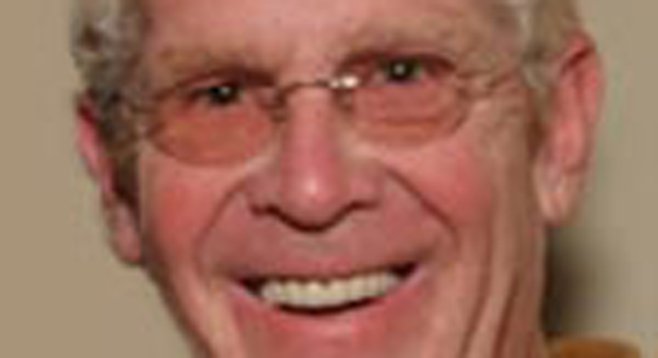 Facebook
Facebook
 X
X
 Instagram
Instagram
 TikTok
TikTok
 Youtube
Youtube

Rich “Brother” Robbin returned to the airwaves last week, spanning six decades of spinning the hits in San Diego.
He returned to afternoons on oldies station Walrus 105.7.
Robbin started in 1969 as a nighttime jock on Boss Radio 136 KGB, when everyone listened to music on AM radio.
Robbin moved to KCBQ in 1971 and became program director there in 1973. He is lauded as San Diego’s most successful rock-radio figure — San Diego’s current top–rated station, KSON, has a 6.0 rating; Robbin’s 1973 KCBQ once ruled local airwaves with a 13.4, dominated by his rapid-fire delivery and upbeat tunes.
Robbin’s first radio gig was as a 14-year-old intern in 1958 at WCCO, Minneapolis. “They still had live-music shows and they would play an occasional 78 RPM record.” He launched a backyard pirate-radio station in 1960 in high school. His first commercial radio gig was 1963, where he spun Top 40 hits from seven-inch 45 RPM records at a station in Redwing, Minnesota. After an Armed Forces Radio Vietnam war stint in Saigon, where he played the hits (think Good Morning, Vietnam), Robbin returned to the U.S. and climbed the radio food chain to rock station KGB in the summer of ’69.
As a programmer, Robbin broke his share of hits: “There was ‘Wedding Bell Blues’ and ‘Proud Mary,’ by Ike and Tina Turner. Then there is the one I never talk about: Marie Osmond’s ‘Paper Roses,’ which went on to reach number five on Billboard’s Top 100.”
And at KCBQ, Robbin witnessed music history: “My boss accidentally played the flip side of Rod Stewart’s ‘Reason to Believe.’ It was ‘Maggie May.’ We played it every hour for two days straight.... Because of KCBQ, ‘Maggie May’ went on to become the second biggest single of 1971.”
After stints in other cities, Robbin came back to the local airwaves in 1992, to the now-defunct oldies station KBEST-95. He left the airwaves in 2001 and started voice-tracking his DJ shifts via digital download to other markets.
When he realized that oldies radio was ignoring certain hits from the ’50s and ’60s, Robbin launched his own internet oldies station, richbroradio.com, from his Ocean Beach home in 2007. “We’ll play 60 to 70 Beatles hits and 30 to 40 Beach Boys hits you just won’t hear on the radio.... So, there I was, living the good life in Ocean Beach,” Robbin tells the Reader, “with the website and my old cars, and along came the Walrus with an offer I couldn’t refuse.”
Whether Robbin gets to play more Seeds and Standells and less Eagles and Michael Jackson remains to be seen. But he and everyone else in terrestrial radio still must compete with Pandora and SiriusXM.
“Radio adds personality and a level of in-your-face excitement that you just can’t get from Pandora. It sure is a hell of a lot more interesting than listening to one song after another on your iPod.”


Rich “Brother” Robbin returned to the airwaves last week, spanning six decades of spinning the hits in San Diego.
He returned to afternoons on oldies station Walrus 105.7.
Robbin started in 1969 as a nighttime jock on Boss Radio 136 KGB, when everyone listened to music on AM radio.
Robbin moved to KCBQ in 1971 and became program director there in 1973. He is lauded as San Diego’s most successful rock-radio figure — San Diego’s current top–rated station, KSON, has a 6.0 rating; Robbin’s 1973 KCBQ once ruled local airwaves with a 13.4, dominated by his rapid-fire delivery and upbeat tunes.
Robbin’s first radio gig was as a 14-year-old intern in 1958 at WCCO, Minneapolis. “They still had live-music shows and they would play an occasional 78 RPM record.” He launched a backyard pirate-radio station in 1960 in high school. His first commercial radio gig was 1963, where he spun Top 40 hits from seven-inch 45 RPM records at a station in Redwing, Minnesota. After an Armed Forces Radio Vietnam war stint in Saigon, where he played the hits (think Good Morning, Vietnam), Robbin returned to the U.S. and climbed the radio food chain to rock station KGB in the summer of ’69.
As a programmer, Robbin broke his share of hits: “There was ‘Wedding Bell Blues’ and ‘Proud Mary,’ by Ike and Tina Turner. Then there is the one I never talk about: Marie Osmond’s ‘Paper Roses,’ which went on to reach number five on Billboard’s Top 100.”
And at KCBQ, Robbin witnessed music history: “My boss accidentally played the flip side of Rod Stewart’s ‘Reason to Believe.’ It was ‘Maggie May.’ We played it every hour for two days straight.... Because of KCBQ, ‘Maggie May’ went on to become the second biggest single of 1971.”
After stints in other cities, Robbin came back to the local airwaves in 1992, to the now-defunct oldies station KBEST-95. He left the airwaves in 2001 and started voice-tracking his DJ shifts via digital download to other markets.
When he realized that oldies radio was ignoring certain hits from the ’50s and ’60s, Robbin launched his own internet oldies station, richbroradio.com, from his Ocean Beach home in 2007. “We’ll play 60 to 70 Beatles hits and 30 to 40 Beach Boys hits you just won’t hear on the radio.... So, there I was, living the good life in Ocean Beach,” Robbin tells the Reader, “with the website and my old cars, and along came the Walrus with an offer I couldn’t refuse.”
Whether Robbin gets to play more Seeds and Standells and less Eagles and Michael Jackson remains to be seen. But he and everyone else in terrestrial radio still must compete with Pandora and SiriusXM.
“Radio adds personality and a level of in-your-face excitement that you just can’t get from Pandora. It sure is a hell of a lot more interesting than listening to one song after another on your iPod.”
Comments